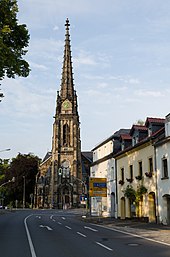Jakobikirche (Freiberg)
The Evangelical Jakobikirche Freiberg is a neo-Gothic church in Freiberg in Saxony . It belongs to the parish Jakobi-Christophorus in the church district Freiberg of the Evangelical Lutheran Church of Saxony and contains, with the altar, baptismal font and organ by Gottfried Silbermann, artistically significant pieces of equipment from earlier times.
History and architecture
The Jakobikirche was built around 1160 as the parish church of Christiansdorf , the oldest settlement in the Freiberg area. In 1887 it was dilapidated. Since the city of Freiberg wanted to use the original location at the corner of Talstrasse / Pfarrgasse for a school, the medieval church was demolished and the current location just outside the old town was chosen for the new building. It was built as a three-aisled hall church between 1890 and 1892 according to plans by Theodor Quentin . The church is an unplastered quarry stone building with structures made of ashlar over a cross-shaped floor plan with a choir polygon. The 57 m high, steeply proportioned tower has a brick pointed helmet with crabs and a finial .
The portal with ogee and tracery fries with sculptures by Peter Pöppelmann designed in the guise Mary and Martha on the left and Paul and James show on the right side; the pelican is shown above the portal as a symbol of self-sacrificing love.
Inside the spacious hall church, similar to the Johanneskirche in Meißen-Cölln, is determined by the slender forms of the Gothic. Ribbed vaults, supported by sturdy pillars with templates and capitals decorated with plants, close off the central nave at the top. The ribs of the narrow aisles and the transept are supported by consoles. All arches and ribs are made of brick. The space is defined by simple galleries on three sides and in the transept arms.
Furnishing
Noteworthy as an early achievement of the preservation of monuments is the takeover of older items of equipment from the previous building. This was the oldest church in Freiberg.
The altar is one of the most important works of Mannerism in Saxony and was created by Bernhard Diterichs and Sebastian Grösgen in 1610. The three-storey structure made of wood shows the Lord's Supper in the predella , in the middle part between double columns the almost fully plastic representation of the crucifixion of Christ with the thieves in front of a relief representation of Jerusalem. The figures of the evangelists Mark and Matthew are attached to the side cheeks . In the essay the burial of Christ is shown between Luke and John. The end of the altar is a blown gable with the figure of Salvator mundi . The finely crafted ivory altar crucifix from around 1710 is attributed to Balthasar Permoser .
The sandstone pulpit is a work by Andreas Lorentz from 1564. It rests without support on a console, the rings of which are decorated with leaf and fruit ornaments. Next to a crucifix on the basket there are expressive representations of Moses receiving the tablets of the Law and of Christ with the disciples.
The "excellent sandstone baptism" with well-formed Renaissance ornaments was created by Hans Walther II in 1555. It shows a similar program of images as the font in Pirna's Marienkirche . At the foot there are seated children in baptismal robes and on the kuppa there are reliefs with the procession of the people of Israel through the Red Sea and Moses knocking water out of the rock. The Saxon and Danish coats of arms refer to the ducal couple August von Sachsen and Anna von Denmark .
organ
The organ by Gottfried Silbermann from 1716/1717 is particularly valuable. The prospectus was designed by the Freiberg cathedral organist Elias Lindner. It was converted into the newly built Jakobikirche in 1892, with an expansion and reworking by Friedrich Ladegast . By rearranging the pipes inside, adding bass pipes and extensions to the prospect pipes, he created a lower pitch tone, added the low c sharp in all keyboards and created an equal pitch . Six new registers were placed on additional pneumatic drawers. In 1905 Jehmlich Orgelbau exchanged a register. In 1954/1955 Jehmlich removed the additional stops from 1892, added two pedal stops with a pipe inventory from 1892 and rebuilt the mixed voices in the main work. The Wegscheider organ workshop carried out a restoration and partial reconstruction in 1995 . Lastly, the work with 20 registers on two manuals and pedal was restored in 2017 by Orgelbau Ekkehard Groß. The disposition is as follows:
|
|
|
|||||||||||||||||||||||||||||||||||||||||||||||||
literature
- Georg Dehio : Handbook of the German art monuments. Saxony II. The administrative districts of Leipzig and Chemnitz. Deutscher Kunstverlag, Munich / Berlin 1998, ISBN 3-422-03048-4 , pp. 273-274.
Web links
Individual evidence
- ^ Georg Dehio : Handbook of German Art Monuments. Saxony II. The administrative districts of Leipzig and Chemnitz. Deutscher Kunstverlag, Munich / Berlin 1998, ISBN 3-422-03048-4 , p. 273
- ^ Frank-Harald Greß : Die Orgeln Gottfried Silbermanns (= publications of the Society of Organ Friends. Volume 177). 3. Edition. Sandstein, Dresden 2007, ISBN 978-3-930382-50-7 , p. 45.
- ↑ Article of the Free Press on the restoration (June 4, 2018). Retrieved November 6, 2019 .
- ^ Organ in Freiberg, Jakobikirche , accessed on January 14, 2018.
Coordinates: 50 ° 55 ′ 2.6 ″ N , 13 ° 21 ′ 1.9 ″ E



